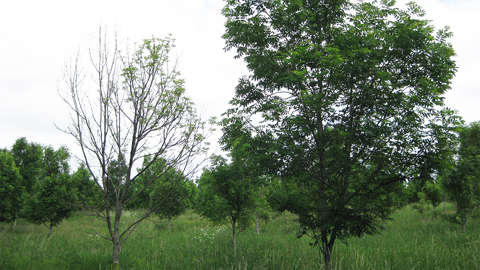From DNA to Rescue: Genomic Research Can Secure the Future of the Ash Tree

European ash trees (Fraxinus excelsior) are threatened by ash dieback, a devastating disease caused by an invasive fungus called Hymenoscyphus fraxineus. This study investigated how some ash trees are more tolerant to this disease than others, by looking at their genes and how the trees change with the seasons.
Researchers from several European countries studied a large collection of ash trees in different locations. They carefully noted how much damage ash dieback caused to each tree, as well as when their leaves changed color in autumn and burst in spring. The researchers also examined the genetic composition of the trees by analyzing their DNA. They used a powerful method called genome-wide association study (GWAS) to find connections between different variants of specific genes and how the trees responded to the disease, as well as the timing of their seasonal changes. To understand how these genes interact, they also used machine learning techniques.
The key findings of the study are as follows:
-
Tolerance to ash dieback is complex and involves many genes, each likely with a small effect. This makes it less likely that the fungus can easily overcome the trees’ defenses.
-
The study confirmed that trees showing earlier leaf yellowing in autumn tend to have less damage from ash dieback.
-
By combining GWAS and machine learning, the researchers were able to explain a significant part of the variation in disease tolerance based on the trees’ genes.
-
Specific genes were identified that are linked to both damage from ash dieback and autumn leaf yellowing. Some of these genes are involved in plant defense mechanisms, helping the tree recognize and fight the fungus. Others are involved in regulating the timing of seasonal events such as leaf yellowing and leaf fall.
-
Interestingly, although damage from ash dieback and autumn leaf yellowing are related, the specific genes most strongly associated with each trait were different. This suggests that although the two are connected, they may be governed by separate sets of genes, with some genes possibly influencing both. For example, some defense-related genes were associated with autumn leaf yellowing.
-
The researchers suggest that both the tree’s ability to actively defend itself against the fungus and its strategy to shed leaves early (phenological avoidance) contribute to tolerance.
This research provides valuable insights into how ash trees can tolerate ash dieback. By identifying these important genes, we can better understand the mechanisms of tolerance and potentially select and breed more resistant ash trees for the future, helping to preserve this important species in European forests. The study also highlights the complex interplay between a tree’s genes, its seasonal patterns, and its ability to fight disease.
Authors:
James M. Doonan (Department of Geosciences and Natural Resource Management, University of Copenhagen, Frederiksberg, Denmark), Katharina B. Budde, Chatchai Kosawang, Albin Lobo, Rita Verbylaite, Jaelle C. Brealey, Michael D. Martin, Alfas Pliura, Kristina Thomas, Heino Konrad, Stefan Seegmüller, Mateusz Liziniewicz, Michelle Cleary, Miguel Nemesio-Gorriz, Barbara Fussi, Thomas Kirisits, M. Thomas P. Gilbert, Myriam Heuertz, Erik Dahl Kjær, Lene Rostgaard Nielsen.
We will review and publish your comment as soon as possible.


